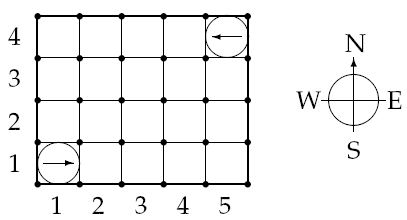Crashing Robots
| Time Limit: 1000MS | Memory Limit: 65536K | |
| Total Submissions: 6791 | Accepted: 2942 |
Description
In a modernized warehouse, robots are used to fetch the goods. Careful planning is needed to ensure that the robots reach their destinations without crashing into each other. Of course, all warehouses are rectangular, and all robots occupy a circular floor space with a diameter of 1 meter. Assume there are N robots, numbered from 1 through N. You will get to know the position and orientation of each robot, and all the instructions, which are carefully (and mindlessly) followed by the robots. Instructions are processed in the order they come. No two robots move simultaneously; a robot always completes its move before the next one starts moving.
A robot crashes with a wall if it attempts to move outside the area of the warehouse, and two robots crash with each other if they ever try to occupy the same spot.
A robot crashes with a wall if it attempts to move outside the area of the warehouse, and two robots crash with each other if they ever try to occupy the same spot.
Input
The first line of input is K, the number of test cases. Each test case starts with one line consisting of two integers, 1 <= A, B <= 100, giving the size of the warehouse in meters. A is the length in the EW-direction, and B in the NS-direction.
The second line contains two integers, 1 <= N, M <= 100, denoting the numbers of robots and instructions respectively.
Then follow N lines with two integers, 1 <= Xi <= A, 1 <= Yi <= B and one letter (N, S, E or W), giving the starting position and direction of each robot, in order from 1 through N. No two robots start at the same position.

Figure 1: The starting positions of the robots in the sample warehouse
Finally there are M lines, giving the instructions in sequential order.
An instruction has the following format:
< robot #> < action> < repeat>
Where is one of
and 1 <= < repeat> <= 100 is the number of times the robot should perform this single move.
The second line contains two integers, 1 <= N, M <= 100, denoting the numbers of robots and instructions respectively.
Then follow N lines with two integers, 1 <= Xi <= A, 1 <= Yi <= B and one letter (N, S, E or W), giving the starting position and direction of each robot, in order from 1 through N. No two robots start at the same position.

Figure 1: The starting positions of the robots in the sample warehouse
Finally there are M lines, giving the instructions in sequential order.
An instruction has the following format:
< robot #> < action> < repeat>
Where is one of
- L: turn left 90 degrees,
- R: turn right 90 degrees, or
- F: move forward one meter,
and 1 <= < repeat> <= 100 is the number of times the robot should perform this single move.
Output
Output one line for each test case:
Only the first crash is to be reported.
- Robot i crashes into the wall, if robot i crashes into a wall. (A robot crashes into a wall if Xi = 0, Xi = A + 1, Yi = 0 or Yi = B + 1.)
- Robot i crashes into robot j, if robots i and j crash, and i is the moving robot.
- OK, if no crashing occurs.
Only the first crash is to be reported.
Sample Input
4 5 4 2 2 1 1 E 5 4 W 1 F 7 2 F 7 5 4 2 4 1 1 E 5 4 W 1 F 3 2 F 1 1 L 1 1 F 3 5 4 2 2 1 1 E 5 4 W 1 L 96 1 F 2 5 4 2 3 1 1 E 5 4 W 1 F 4 1 L 1 1 F 20
Sample Output
Robot 1 crashes into the wall Robot 1 crashes into robot 2 OK Robot 1 crashes into robot 2
题意很简单,就是模拟一个地图,通过输入确定机器人的位置和移动,判断机器人移动后的状态。
难就难在数据结构的选择上,由于平时做题都是用数组,单一变量的,没有考虑到结构体,导致这个题完全没有思路。
通过 网上找的c++答案,改成C后运行错误。
通过调试发现对字符的输入使用错误。
应该用scanf(" %c")而不是scanf("%c");这样做可以过滤掉字符前的空格。
因为scanf("%c")可以读取空格!!!!切记!!!
代码的巧妙之处就在于用结构体来输入数据。
代码如下:
#include <stdio.h> #include <string.h> #include <stdbool.h> #define LOCAL struct rob { int x,y,dre; }robot[101]; struct instruction { int rb_id,step; char point; }ins[101]; int map[101][101]; int a,b; bool process(struct instruction act); int main(void) { #ifdef LOCAL freopen("data.in","r",stdin); freopen("data.out","w",stdout); #endif int ncases; int m,n; char ch; scanf("%d",&ncases); while(ncases--) { memset(map,0,sizeof(map)); memset(ins,0,sizeof(ins)); scanf("%d%d",&a,&b); scanf("%d%d",&n,&m); int i; for(i=1;i<=n;i++) { scanf("%d%d",&robot[i].x,&robot[i].y); scanf(" %c",&ch); if(ch=='N') robot[i].dre=0; if(ch=='W') robot[i].dre=1; if(ch=='S') robot[i].dre=2; if(ch=='E') robot[i].dre=3; map[robot[i].x][robot[i].y]=i; } for(i=1;i<=m;i++) { scanf("%d",&ins[i].rb_id); scanf(" %c",&ch); scanf("%d",&ins[i].step); if(ch=='L') ins[i].point=1; else if(ch=='R') ins[i].point=-1; else ins[i].point=0; } //输入 for(i=1;i<=m;i++) { if(!process(ins[i])) break; } if(i>m) printf("OK\n"); } return 0; } bool process(struct instruction act) { int i; int id=act.rb_id; while(act.step--) { if(act.point==1) robot[id].dre=(robot[id].dre+1)%4; else if(act.point==-1) { robot[id].dre-=1; if(robot[id].dre==-1) robot[id].dre=3; } else if(act.point==0) { map[robot[id].x][robot[id].y]=0; switch(robot[id].dre) { case 0:robot[id].y++;break; case 1:robot[id].x--;break; case 2:robot[id].y--;break; case 3:robot[id].x++;break; } if(robot[id].x<1||robot[id].y<1||robot[id].x>a||robot[id].y>b) { printf("Robot %d crashes into the wall\n",id); return false; } else if(map[robot[id].x][robot[id].y]) { printf("Robot %d crashes into robot %d\n",id,map[robot[id].x][robot[id].y]); return false; } map[robot[id].x][robot[id].y]=id; } } return true; }






















 176
176

 被折叠的 条评论
为什么被折叠?
被折叠的 条评论
为什么被折叠?








